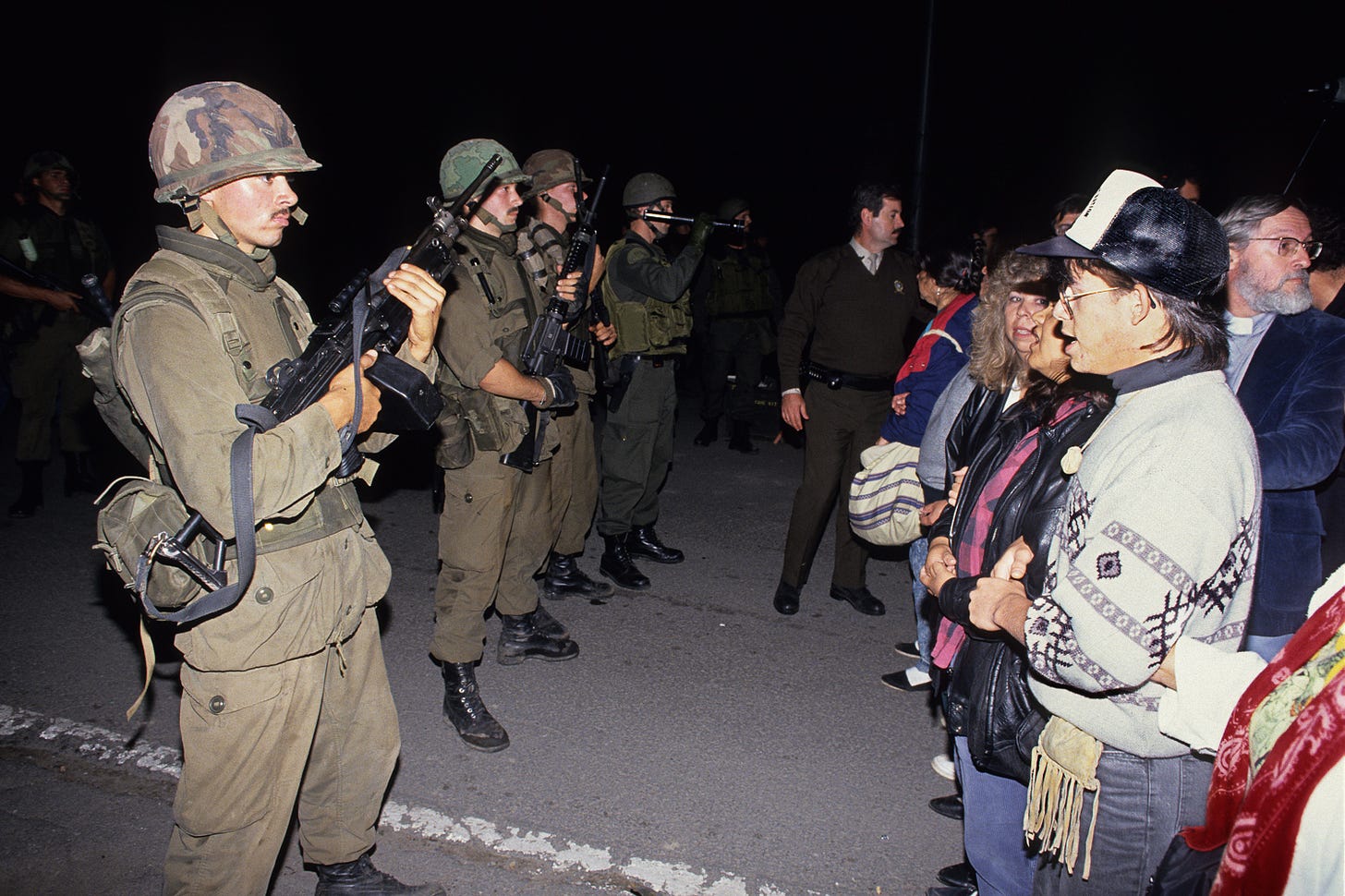Remembering Oka - A defining moment in Indigenous-Crown Relations
Includes Audio Interview with Bud Morris
Today many look back upon the 78-day Oka standoff between the state and the Mohawks as win for Indigenous-Crown relations, all through the summer of 1990, the Oka conflict was the top story in Canadian media, both print and television. The armed warriors inspired widespread support & solidarity from Indigenous people throughout the country. Protests, occupations, & blockades were numerous, indicating the great potential for rebellion amongst Indigenous peoples. This unity & solidarity tempered the use of lethal force by the Canadian Government in ending the standoff.
Oka had a profound effect on the Indigenous population, it was the single most important factor in reinvigorating the latent warrior spirit of the people while exemplifing Indigenous sovereignty, and the necessity of armed defence against violent aggression by external forces.
However, even today the Pines find themselves back at the centre of ownership dispute between Oka and the Mohawks, and the Federal and Provincial Governments continue to pass legislation that affects Treaty rights without fulfilling their constitutional duty to consent
Before our interview with Bud, who was at Oka for the duration, let’s quickly recap the timeline of events:
April 1, 1989
Mohawks tell Oka mayor, 'This is our land' "I will occupy this land if that's what it takes," vows Grand Chief Clarence Simon
March 10, 1990
Occupation of the Pines begins, Mohawks drag a fishing shack into the Pines and block access to a snow-covered dirt road
April 26, 1990
Oka seeks injunction to dismantle barricade, a spokesperson for the town says "We can't stand by while public roads are blocked," while the following characterizes the sentiments of the protesters "If I have to die for Mohawk territory, I will"
May 7, 1990
"It's an illegal occupation," says Oka Coun. Gilles Landreville as rumours of masked an armed members of the Mohawk Warrior Society begin to circulate, Kanesatake denies allegations.
July 4, 1990
We're not going to allow them to take the barricade down," says Mohawk artist and protester Ellen Gabriel after the city of Oka issues a second injunction against Kanesatake
July 5, 1990
Public Security Minister Sam Elkas gives the Mohawks four days to dismantle the barricade and the protest camp in the Pines or suffer the consequences
July 9, 1990
Federal negotiator Yves Désilets shows up, however, the Mohawks in the camp harden their stance, demanding "nation-to-nation" talks directly with Prime Minister Brian Mulroney.
July 10, 1990
Oka Mayor Jean Ouellette makes a formal request to the Quebec provincial police, "We are counting on you to settle this problem without any further delays or requests on our part"
July 11, 1990
Provincial police release tear gas on what had been to that point mostly peaceful protesters, the Mohawks refuse to budge and gunfire is exchanged. SQ Corporal Marcel Lemay dies in altercation. Later in the day Kahnawake Mohawk warriors block the Mercier bridge and all approaching highways in solidarity with Mohawks in Kanesatake.
July 12, 1990
Kahnawake food supplies are already in short supply as they find themselves cut off, Quebec Native Affairs Minister John Ciaccia arrives to attempt negotiations.
July 14, 1990
The first Mohawk effigy is lit ablaze.
July 19, 1990
Indigenous Canadians are holding solidarity protests across the country. Tom Siddon, Federal Indian Affairs Minister commits to buy the disputed land at Oka but demands the barricades come down.
Aug 8, 1990
Quebec Premier Robert Bourassa invokes the National Defence Act, calling on the Canadian military to replace Quebec provincial police in Oka and Kahnawake
Aug 20, 1990
The Royal 22nd Regiment moves in hundreds of troops, enclosing the Mohawk community of Kanesatake from all sides
Aug 29, 1990
Lieutenant-Colonel Robin Gagnon negotiated a "military-to-military" agreement with Mohawk warriors at Kahnawake to dismantle the barricades on the Mercier Bridge, a process that took eight days
Sept 1, 1990
The Canadian army tightens the noose, closing in on the remaining Mohawk Warriors at the site of the original barricade in the Pines
Sept 26, 1990
After a 78-day impasse Oka Mohawk warriors abandon the barricades
Sept 27, 1990
In all, about 150 Mohawks and 15 non-Mohawks were charged with various crimes. Most were granted bail, and most were acquitted. Ronald Cross and Gordon Lazore were held for nearly six months before being released on $50,000 bail. They were later convicted of assault and other charges.
Jan 11, 2021
The Mohawk Council of Kanesatake vows to take the municipality of Oka to court over what it calls an "illegal" bylaw concerning the land that was at the heart of the Oka Crisis. The bylaw states anyone who cuts down a tree, constructs a building or divides a lot, for example, without giving the municipality 45 days' notice is committing an infraction. Grand Chief Serge Otsi Simon says "Oka does not have any authority over us. Those lands are ours. Always have been"
In fact, title to reserve land is vested in the Crown, meaning that the Crown (Canadian Government) has an existing and disposable right to the immediate or future possession and enjoyment of property. Meaning that after the last of us has assimilated into the dominant culture, the Crown will take that land back, and do with it as it sees fit.
Thanks for reading, please enjoy this interview with Bud Morris and his first hand account of the Incident at Oka.
Darren Grimes
We want to hear from you! Got an opinion, story, or issue you’d like to get out?
Reply to any of our emails to submit and we will send the best out to the network of thousands of Indigenous Canadians!






